Pain and Tension in the QL Muscles
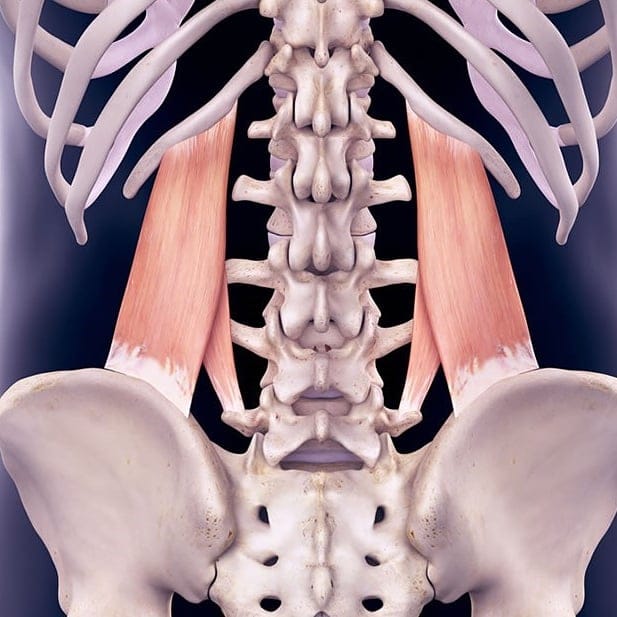
ANATOMY
The quadratus lumborum is the deepest muscle of the posterior abdominal wall, sitting on either side of the lumbar spine between the iliac crest of the pelvis & the 12th rib. It also inserts at the transverse processes of the 1-4th lumbar vertebrae.The colon, the kidneys & diaphragm sit in front of the muscle, & the muscles of the back lie on the dorsal side.
FUNCTION OF THE QL
· used to sit, stand, & walk, hence it is one of the main causes of lower back pain
· stabilization of the spine & pelvis
· helps support the core of the body when breathing
· bilateral contraction - fixes ribs during inspiration & allows extension of the lumbar vertebral column required for movement such as arching the lower back
· an accessory muscle of expiration, due to its ability to fix the 12th rib during thoracic movement
· unilateral contraction - enables lateral flexion ie. bending the torso to one side
CAUSES OF A TIGHT QL & QL PAIN
· OVERUSE -repetitive movements combined with weak muscles lead to postural problems
· SITTING FOR PROLONGED PERIODS - particularly using a reclined position
1. releases the intrinsic back muscles & weakens them in the long term - the quadratus lumborum compensates causing pain & tension
2. causes continuous contraction of the QL resulting in muscle fatigue
3. reduces blood flow to the muscle causing tension
· IMPROPER LIFTING/BENDING/TWISTING - creates further tension as the QL has to overcompensate to stabilize the spine & pelvis
· POOR POSTURE - slouching, leaning to one side, or sitting without lumbar support places stress on the QL
· WEAK SURROUNDING MUSCLES - may cause QL to work harder than necessary to support the torso
· IMBALANCE OF THE PELVIS/SPINE - eg. unequal leg length, causing a lateral pelvic tilt, means that the QL has to work harder stabilize
· TRAUMA - direct injury eg. car accident, sports injury can lead to pain
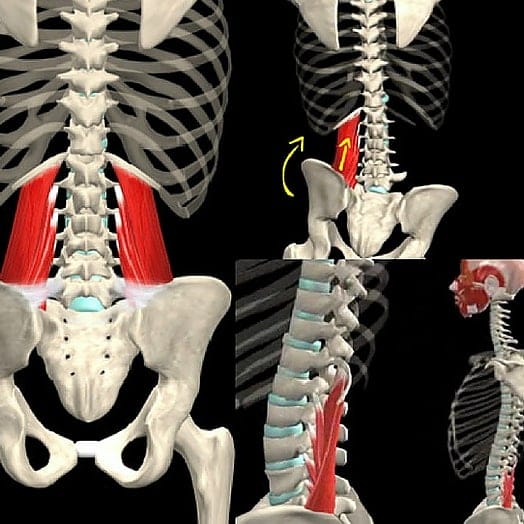
ASYMMETRICAL TIGHTNESS OF THE QL
More often than not QL tightness will occur on one side only, due to our tendency to hold the body in a slightly tilted position, causing an imbalance between the two QL muscles. When we regularly stand with our weight shifted to one side, for example, the muscles adapt, causing them to become too long or too short. In cases of lateral pelvic tilt (see previous posts) the side on which the hip is hiked up will reduce the space between the pelvis and the lower rib, so the corresponding QL will become short & tight. The QL on the opposite side of the body will become long and stretched.
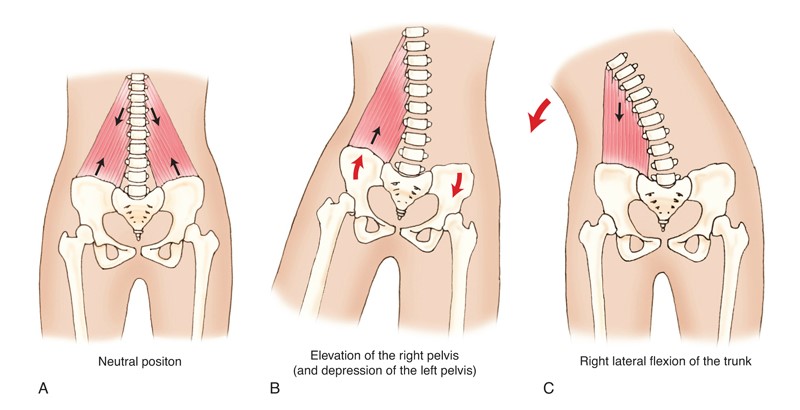
This imbalance will affect the posture further, cause overcompensation of other muscles and place additional stress on other joints, thus worsening pain levels.
COMPLICATIONS OF QL TENSION
A tight QL may cause:-
· pain in your hip joints, buttocks, & thighs
· pain in your sacroiliac joint
· low back pain
· abdominal pain
SYMPTOMS OF A TIGHT QL
· lower back pain - bilateral or unilateral, deep ache or sharp, worse with movement
· sharp pain on sneezing/coughing
· pain may become chronic, leading to anxiety & depression
· tightness in the lower back, limiting range of motion
· restricted daily activities · uneven hip height/lateral pelvic tilt
QL TRIGGER POINTS
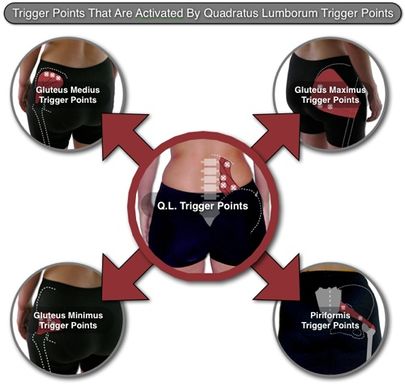
QL trigger points may cause:-
· a deep ache in your lower back
· a stabbing pain in your hips or pelvis
· a sharp pain with QL contraction while coughing or sneezing
TREATMENT
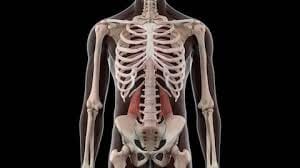
Addressing a tight QL promptly is important, not only to ease pain, but also to restore the balance to your hips, improving posture & athletic performance. If symptoms persist after 2 weeks with conventional treatments it is time to see a doctor.
· MEDICATION - muscle relaxants, anti-inflammatory pain medication
· HEAT/ICE - alternate ice to reduce inflammation & heat to relax the muscle, ease pain & improve blood flow
· TRIGGER POINT INJECTIONS - administration of anaesthetic or steroid medication directly into the trigger point to reduce tenderness, muscle spasms or inflammation
· PHYSIOTHERAPY
· MASSAGE THERAPY - myofascial release, trigger point therapy, sports massage to reduce tension & improve blood flow
· ACUPUNCTURE
· ROLFING
· YOGA - shown to help with QL pain and mental wellbeing in cases of chronic pain
· STRETCHING - to ease tension in muscles & improve range of motion
· POSTURAL CHANGES - avoid positioning hips in an unnatural position with one hip higher than the other
PREVENTION
· maintain good posture when sitting & standing, using a lumbar support
· take regular breaks if you have a sedentary lifestyle
· stay active - focusing on stretching & strengthening, side bends to release back tension & exercises to increase the space between your ribs & pelvis. Yoga, pilates, tai chi & walking are beneficial
· bend at the knees to lift, not the waist
· maintain a healthy weight
· if symptoms appear, treat early
· avoid holding one hip higher than the other for prolonged periods eg:-
1. sleeping on one side – the upper hip often bends toward the rib cage, shortening the QL on that side
2. arching your back – people with sedentary lifestyles may sit up straight by arching the lower back in an effort to improve posture, but if held for a long time this shortens the QL bilaterally
3. repeatedly lifting one hip – eg.leaning toward one arm rest more than the other when seated
STRETCHES FOR THE QL
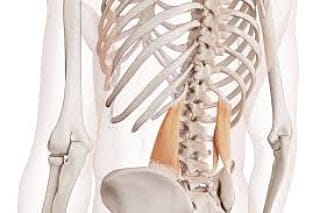
When one QL is tight the opposite QL tends to be stretched & therefore weak. In order to improve stability & correct this imbalance the stretched side must be strengthened, while the tight side must be relaxed. Side planks can be used to strengthen the weak side, while massage & the following exercises can be used to stretch out the tight side. Hip symmetry can then be achieved & posture improved.
1.OVERHEAD REACH
- stand with feet hip-width apart, reach the left arm up & over the head & lean to the left, as far as is comfortable. Hold for 20 seconds. Repeat the other side.
2.LYING DOWN QL STRETCH
- lying face up, extend the arms fully to either side. Bend both knees & cross the right leg over the left leg. Let the legs drop to the right, as far as possible. Hold for 20 seconds. Repeat the other side.
3. QL 90 DEGREE LEG STRETCH
- similar position to exercise no.2 but seated on the floor. If left side is tight, put left hip behind you at a 90 degree angle with the other foot in front also at a 90 degree. As you reach forward with your left hand, push your left hip away from the outstretched hand, stretching the QL area. Lean forward to stretch further.
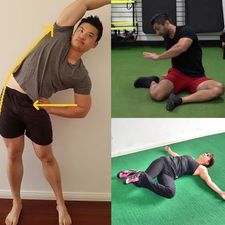
4. LEG SPLIT WITH QL STRETCH
- this stretch requires some flexibility in the legs. Sitting on the floor, legs wide apart, reach to the opposite side & try to touch your toes, stretching the QL area. Repeat the other side.
5. QL STRETCH WITH STABILITY BALL
- stretch over a stability ball & turn yourself onto one side, keeping both feet on the floor, one foot in front of the other & maintaining your balance with one arm on the ground. Reach the other arm in the air & pull it away from the hip to feel a stretch in QL area.
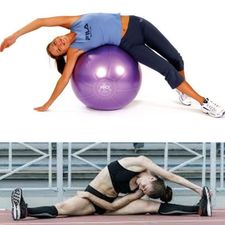
6.CHILDS POSE WITH SIDE REACH
- in a child’s yoga pose stretch arms forward as far as you can, then walk your hands out to the opposite side of the QL you want to stretch, lengthening the lower torso as much as possible.
7. SIDE REACH WITH FORWARD BEND
- stand up straight & reach out to one side, lengthening the side of the body by pushing your hips down & arms up. Once in maximum stretch, bend forward hinging at the hip, & to the side maintaining length in the lower back. Repeat on the other side.
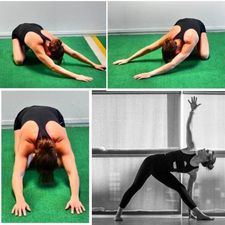
OVERCOMING QUADRATUS LUMBORUM (QL) PAIN
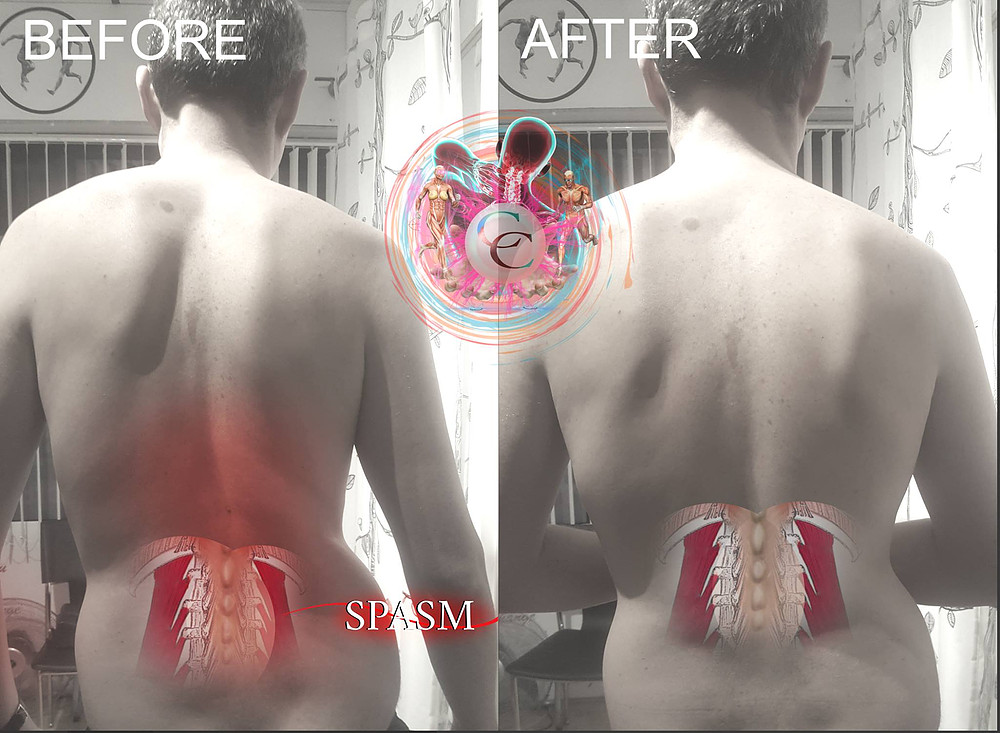
I have previously posted about the quadratus lumborum muscles, what can cause tension in this area and exercises to stretch the muscle, helping to correct any imbalances. I see a lot of clients who are experiencing chronic pain and spasms in the lower back, hips or pelvis due to these muscles being tight, to the point where normal activities, even sleeping, become difficult.
Despite identifying both the areas of tension and of weakness and stretching accordingly, and acknowledging how the core muscles, glutes, obliques and adductors are all linked to the QLs, the pain can often linger.
I previously talked about how the QLs attach to the bottom rib, lumbar vertebrae 1-4 and the ilium of the pelvis, and assist with :-
- lateral lumbar flexion or side bending ie. moving the ribs towards the hip on the same side
- elevates the pelvic ilium ie moving the ilium toward the lower ribs on the same side
- lumbar extension ie. bilateral QL contraction enables movement into a backwards bend
- spinal rotation
- fixes 12th rib during forced exhalation
The QL often becomes tight and painful due to overcompensating, not only from a lateral pelvic tilt, but also other areas which are dysfunctional, for example:-
- helping to abduct/adduct/rotate the hip joint when the glutes are tight or weak
- helping to maintain posture when the erector spinae are weak
- fixing the lower rib during inhalation when the diaphragm is dysfunctional
- when femur movement in the pelvis is limited
Since these are not intended functions for the QL, when the tight QL continues to suffer fatigue due to the extra demand placed upon it in the long term, not only will trigger points develop, but blood flow in and out of the muscle will also lessen, meaning that the risk of muscle spasms and serious injury greatly increase. While stretching, massage therapy etc can offer a short term solution, the root cause is not being addressed.
Possible signs that I will look for when seeing a client with QL pain include:-
- observing any hip hike when standing
- observing asymmetry in the lateral curve of the body
- observe any rib flaring or holding the ribs when twisting or bending backwards
- tendency to slump compressing the lumbar spine into the pelvis – kyphosis has been linked to a tight QL
Sometimes by relaxing the obliques and glutes and opening up the ribs to improve breathing, changes can happen.
